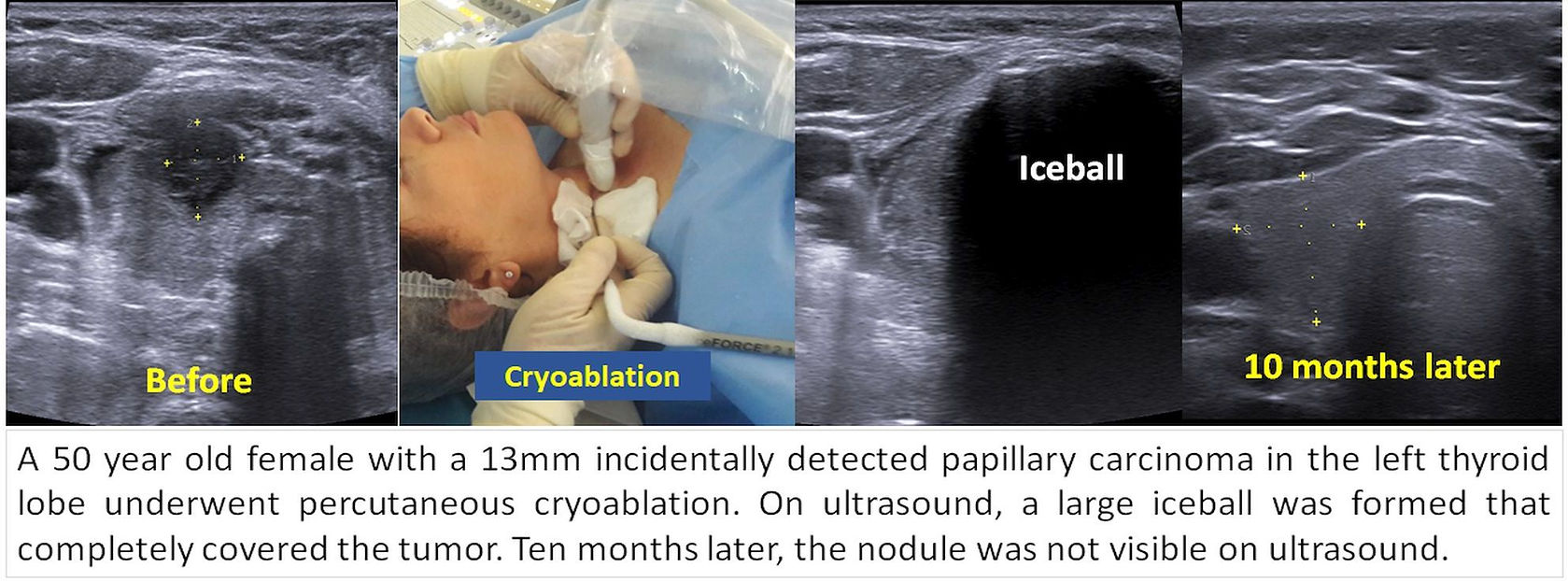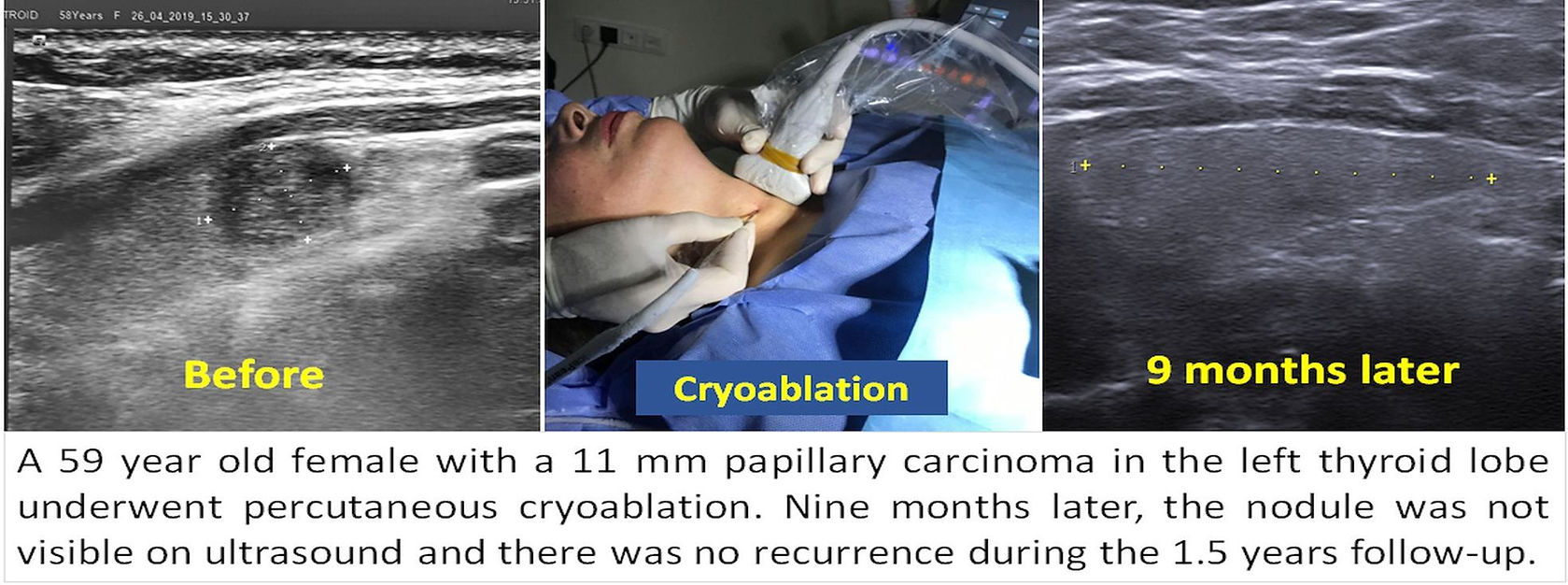Cryoablation
Cryoablation is a new method for ablating thyroid nodules, but with a very high potential. In cryoablation, the tumor tissue is killed by freezing at -140 degrees and rendered harmless. The body also eliminates the dead tissue by shrinking it over time with its own natural mechanism.
Cryoablation is a method that has been used successfully for years in the treatment of prostate, kidney and liver cancers. Oncological outcomes in eligible patients are similar to surgery. Unlike other ablation methods, cryoablation freezes and destroys the tissue. Due to this feature, it has the following advantages.
1. The procedure is much less less painful, because cold application has a natural local anesthetic effect. Therefore, the patient does not need anything more than local anesthesia during the procedure.
2. Cryoablation is far less painful than RFA or laser also in the postoperative period. The patient may have some swelling and bruising in the neck but typically there is very little or no pain.
3. The frozen area during cryoablation can be instantly seen on ultrasound and computed tomography. This feature is not present in any other ablation method. The visibility of the frozen ablation area makes the ablation process safer and more effective. This provides an important advantage in organs close to important vessels and nerves such as the thyroid.
4. In cryoablation, the size and shape of the freezing process can be adjusted according to the size and shape of the tumor. If necessary, the ablation area can be enlarged using more than one needle. This allows us to be able to treat larger nodules that are not suitable for laser, microwave or radiofrequency.
5. In heat based ablations such as laser, MW or RFA, the aim is to kill most of the nodule tissue and cause it to shrink. In cryoablation, as the operator can see the frozen area instantly, the aim is to kill all the nodule tissue completely. This feature allows us to be able to treat difficult nodules such as malignant or toxic nodules more safely and effectively.
Why do we prefer cryoablation in the thyroid?
How is it done?
First, the nodule to be ablated in the thyroid is detected by ultrasound. Then, the skin entry site is anesthetized with local anesthesia and the appropriate sized cryoablation needle is inserted into the nodule under ultrasound guidance. At this stage, the device is turned on and the freezing process begins. During cryoablation, an ice ball quickly forms around the needle in the center of the nodule. The iceball, seen as a black area, grows larger and engulfs the thyroid nodule and freezes it to death. In order for the nodule to be killed completely, the freezing process is usually repeated 2-3 times. During the procedure, the function of the vocal cord nerve is checked by making the patient speak intermittently. After the procedure is finished, the cryoablation needle is withdrawn and the patient is discharged after being observed for a few hours.

In what situations is it used?
Laser, radiofrequency and alcohol ablation of the thyroid are the most commonly used methods in the treatment of benign nodules. The aim is to destroy most of the nodule and make it smaller by constantly moving the needle (moving shot technique). So the goal is to make the nodule shrink rather than kill it completely. However, these methods are not sufficient for cancerous nodules, because in order to treat the cancer, the entire nodule must be killed together with a thin healthy tissue around it (safety margin). In addition, the moving shot technique is not suitable for cancerous nodules, as it may cause the cancer cells to scatter into the surrounding tissue. Therefore, in malignant tumors, ablation without moving the needle is preferred.
In these respects, cryoablation is a more appropriate ablation method for nodules suspected or diagnosed with cancer in the thyroid. In cryoablation, the needle is placed in the middle of the nodule and is not moved until the ablation is complete. In addition, it can be seen on ultrasound that the formed ice ball completely covers the nodule and it can be ensured that the tumor is completely engulfed by the ice and killed. If the ice ball approaches the skin, veins and nerves, this can be seen immediately and necessary measures can be taken to protect these structures.

For these reasons, cryoablation is the most preferred method in our Varisson Clinics in the treatment of thyroid nodules diagnosed as cancer or suspected to have cancer on biopsy. In our clinics, we have applied percutaneous cryoablation in hundreds of such patients since 2017 and none of our patients have developed a permanent complication, and no recurrence has been observed in the treated tumor. With cryoablation, we were able to treat also large (upto 5 cm papillary or follicular cancers) successfully.
In our experience, cryoablation produces more volume reduction than laser or RFA in large benign nodules, cystic nodules resistant to alcohol ablation and also toxic nodules. Again, this can be explained by the fact that cryoablation is able to kill the nodule completely whereas the other ablations kill the nodules only partially.
CONSULTATION FORM
You can get information on our treatments via phone and e-mail as well as by filling and sending the consultation form below. Please send the reports of your thyroid ultrasound, hormones, scintigraphy and biopsy (if available) via e mail (thyroidgoiter@gmail.com) or whats up ( +90-534-551 0 551). Remember to write clearly your e mail address and phone number so that we can return to you as soon as possible.
Please send separately the results of your thyroid ultrasound, hormones, scintigraphy and biopsy (if available)